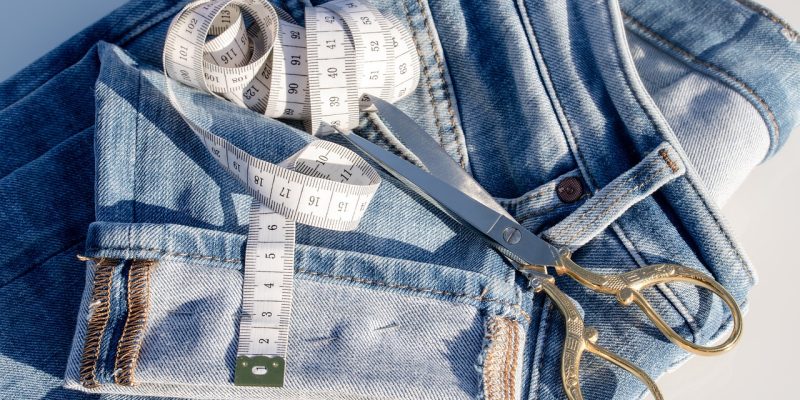Jeans are a staple in many wardrobes, offering both comfort and style. However, finding the perfect pair that fits your body shape perfectly straight off the rack can sometimes feel like searching for a needle in a haystack. That’s where tailoring comes in – a little nip here, a tuck there, and voilà, you have a pair of jeans that seem like they were made just for you. But how much does it cost to get jeans tailored? Let’s dive into the world of jeans tailoring to explore the costs involved in achieving that perfect fit.
Understanding the Basics of Jeans Tailoring
Jeans tailoring encompasses a variety of alterations, designed to refine the fit and enhance the comfort of your denim. At its core, tailoring can address simple needs such as shortening the length, but it can also extend to more detailed modifications including adjusting the waist, hips, or even reimagining the overall silhouette of your jeans. The feasibility and outcome of these alterations significantly depend on the tailor’s expertise and the fabric quality of the jeans themselves.
High-grade denim offers more flexibility for alterations, capable of withstanding modifications without compromising the garment’s integrity. On the other hand, jeans made from lower-quality materials may not fare as well under extensive changes, potentially affecting the durability and appearance of the final product.
Tailors bring an array of skills to the table, enabling them to perform alterations that range from the straightforward to the complex. For simpler tasks like hemming, the process is relatively uncomplicated. However, for more intricate adjustments such as tapering the leg or resizing the garment, a tailor must meticulously deconstruct and reconstruct portions of the jeans, a process that demands precision and expertise.
Understanding the scope of what can be achieved through tailoring is crucial before you bring in your pair of jeans. Not every alteration is possible or advisable, depending on the jean’s original fit, style, and material. Thus, consulting with a skilled tailor can provide clarity on what modifications can be made, ensuring your denim not only fits better but also maintains its quality and style after the alterations.
The Cost of Hemming Your Jeans
Hemming jeans is a popular and relatively simple alteration, primarily focused on adjusting the length to suit your height or to complement specific footwear choices. The price for this service typically falls between $10 and $20, influenced by various factors including the tailor’s expertise and the hemming technique utilized.
Opting for a specialized hemming method, such as preserving the original hem for a more authentic look, can push the price toward the upper limit of this range. It’s worth noting that while the process is less complicated than other types of alterations, the cost can still vary based on the tailor’s location and the denim’s fabric properties.
Heavy or particularly unique denim might require more time and precision, potentially affecting the final price. When selecting a service for hemming, it’s beneficial to consider these elements to understand the associated costs better. This awareness can help you make an informed decision that balances your budget with the desired outcome, ensuring your jeans not only fit perfectly but also reflect your style preferences accurately.
Adjusting the Waist and Hips for a Perfect Fit
Adjusting the waist and hips of jeans is a common alteration for those seeking a closer, more personalized fit. When jeans fit perfectly in the legs but are too roomy or tight around the waist and hips, a skilled tailor can work wonders. This alteration involves careful manipulation of the fabric—either removing excess material to tighten the fit or adding fabric, possibly from the jeans’ own hem or a matching denim, to accommodate a larger size.
The process typically starts with opening the waistband or side seams to access the areas requiring adjustment. For reducing the size, the tailor takes in the excess material and sews it back with precision to ensure the adjustment is seamless and unnoticeable.
Conversely, expanding the waist or hips might require adding denim patches that closely match the original fabric in color and weight, a task that requires a keen eye for detail and expertise in blending the new material with the old.
Prices for waist and hip adjustments vary, generally falling between $20 to $50. The variation in cost reflects the complexity of the alteration and the tailor’s experience. Factors such as the design of the jeans, whether they have multiple seams or a unique construction, can also influence the price.
Additionally, the type of denim—be it heavy-duty, stretch, or a delicate vintage fabric—plays a role in determining the alteration’s difficulty and, consequently, the cost.
Tailoring the waist and hips not only ensures a better fit but also enhances the overall appearance of the jeans, making this alteration a valuable option for those looking to refine their denim to match their unique body shape.
Tapering the Legs for a Modern Silhouette
Tapering the legs of jeans is a sought-after alteration for those aiming to give their denim a more contemporary, fitted look. This procedure involves reducing the width of the jeans from the knee down to the ankle, or adjusting the entire length of the leg, to achieve a sleek, tailored fit. The specific process of tapering can adjust the silhouette to flatter the wearer’s shape, shifting a looser pair of jeans into a streamlined profile that aligns with modern fashion trends.
The cost for tapering can range from $20 to $45, a reflection of the meticulous effort required to resize and reshape the garment. The process may entail opening the inner or outer seams of the jeans, removing the excess fabric, and then carefully sewing the denim back together to create a narrower leg. The price variance largely depends on the extent of the alteration and the structure of the original jeans.
For example, tapering the entire leg length involves more work than simply narrowing the area from the knee to the ankle, potentially impacting the final cost.
Factors such as the original cut of the jeans, the presence of unique design elements (like embellishments or special stitching), and the type of denim fabric also play crucial roles in the complexity of the alteration. Jeans constructed from heavy or stretch denim may pose additional challenges, requiring specific techniques to ensure the altered jeans maintain their fit and comfort while achieving the desired tapered look.
Tailors must navigate these considerations with precision, balancing the integrity of the denim with the alteration goals, which in turn influences the price.
The Expense of Major Alterations
When it comes to more extensive modifications such as significantly resizing your jeans or completely changing their silhouette, the financial investment increases correspondingly. These alterations are not only time-consuming but also require a high degree of craftsmanship.
The tailor has to meticulously deconstruct and then precisely reconstruct the jeans, ensuring that the integrity and aesthetic of the denim are preserved. This level of alteration might include comprehensive resizing, extensive repairs, or reimagining the style and shape of the jeans to fit current fashion trends or personal preference.
Costs for these major alterations typically start at around $50, but they can exceed $100 based on the complexity and labor involved. Factors that contribute to the higher cost include the amount of material to be added or removed, the necessity for matching new denim to the original fabric, and the intricacy of the jeans’ design.
Jeans with elaborate stitching, unique embellishments, or those made from particularly tough or stretchy denim materials present additional challenges that can extend the time and skill needed to complete the alterations.
The tailor’s location also significantly affects pricing. Tailoring services situated in major cities or upscale neighborhoods often have higher rates due to increased operational costs. Similarly, the reputation and experience level of the tailor can influence the cost, with highly skilled professionals commanding premium prices for their expert services.
Opting for major alterations is a commitment to both your wardrobe and your wallet, but the result is a customized pair of jeans that fits your body and style preferences impeccably.
Factors Influencing the Cost of Tailoring Jeans
Several elements play a pivotal role in determining how much you will pay for jeans tailoring. Among these, the nature of the alterations needed stands out; more intricate work like resizing or modifying the jeans’ silhouette demands higher precision and time, leading to increased costs. The expertise and reputation of the tailor also significantly affect pricing, with seasoned professionals often charging more for their advanced skills and quality craftsmanship.
The location of the tailoring service is another critical factor; services in metropolitan areas or in high-end retail settings typically incur higher fees due to elevated rent and operational expenses.
Additionally, the material of the jeans impacts the cost of tailoring. Denim that is heavy, has a unique weave, or incorporates stretch fabric might require specialized handling or more labor-intensive techniques, influencing the final price. The specific design details of the jeans, such as embroidery, special stitching, or unique finishes, can complicate the alteration process, potentially requiring more time and expertise to preserve these elements effectively during modifications.
Furthermore, when adding material to the jeans—for instance, in waist or hip adjustments—the need for matching the original denim closely in terms of color, weight, and texture can introduce additional costs, particularly if the material is rare or high-quality. Each of these factors contributes to the overall cost of tailoring, underscoring the importance of discussing your alteration needs and expectations with a tailor to gauge the potential investment required for custom-fitting your denim.
DIY Alternatives to Professional Tailoring
Embarking on the journey of DIY denim alterations is both a cost-effective and rewarding endeavor for those inclined towards crafting. With the wealth of online resources available, including step-by-step videos and blogs, mastering basic modifications like hemming or tightening the waistband is within reach for most enthusiasts. Initiating your tailoring adventure with simpler projects allows you to gradually build confidence and skill, potentially leading to tackling more complex adjustments over time.
Before diving into DIY alterations, it’s crucial to assess the tools and materials you’ll need. Basic sewing supplies, such as a sturdy needle, thread matching your denim’s color, fabric scissors, and possibly a seam ripper, are essential. For those interested in a more professional finish, investing in a sewing machine that can handle denim fabric may be worthwhile.
Practicing on an older pair of jeans can provide valuable hands-on experience without the risk of damaging a favorite pair. This trial run allows you to familiarize yourself with the fabric’s behavior, such as how it frays or stretches, and refine your technique before moving on to more beloved garments.
It’s important to approach DIY tailoring with patience and realistic expectations. While not every alteration will be perfect, each attempt offers learning opportunities. Remember, complex alterations that significantly alter the structure of the jeans, such as resizing or adjusting the rise, might still be best left to professional tailors. However, for simple fixes and creative modifications, the DIY route can be both enjoyable and fulfilling, offering a personalized touch to your denim collection.
Maximizing Your Investment in Tailored Jeans
Choosing a high-quality denim foundation is the first step in ensuring your tailoring endeavors are worthwhile. Opt for jeans that nearly match your ideal fit from the start, focusing on aspects like the waist and hip measurements that are closer to your body’s specifications. This strategy limits the extent and complexity of alterations required, potentially saving on costs. Additionally, it preserves the integrity and longevity of the denim, as less invasive modifications are needed to achieve your perfect fit.
When selecting jeans for tailoring, consider the fabric’s weight and stretch. These attributes affect how well the alterations will hold up over time and can influence the overall look and comfort of the finished product. Jeans crafted from durable materials with the right amount of give are more likely to maintain their shape and fit after being altered.
Another aspect to consider is the style and construction of the jeans. Pieces with minimal embellishments and straightforward designs lend themselves more easily to alterations. Simplifying the tailoring process not only aids in keeping costs manageable but also in maintaining the original aesthetic of the jeans.
Lastly, engage in open communication with your tailor about your expectations and the feasibility of desired alterations. A skilled tailor can offer valuable insights into what adjustments will best suit the jeans’ fabric and design, ensuring your investment yields a pair of tailored jeans that fits flawlessly, aligns with your personal style, and stands the test of time, making them a cherished component of your wardrobe.













Comments